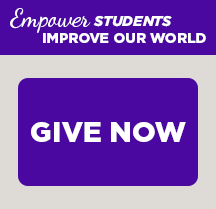April 18, 2012
Winona State’s Light the Way campaign surpasses its goal with more than $14 million.
Thanks to 13,364 shining lights the future is much, much brighter for Winona State University and tens of thousands of people in our community.
Light the Way, Winona State’s first comprehensive capital campaign, has successfully concluded by surpassing its original $10 million goal. With more than 32,000 gifts – large and small, from every corner of the community – the campaign raised a total of $14,522,570 to date.
It’s heartening that those who gave included 7,364 alumni, 2,664 parents of students, 1,676 friends of WSU, and 546 faculty and staff members. Nearly 4,500 of those “shining lights” were first-time donors. Each of those gifts shows your commitment to enhancing educational opportunities for our students, and reaffirms your belief that Winona State improves the world.
And how is your overwhelming generosity being put to use? These stories demonstrate how Light the Way is changing the lives of deserving students, creating the tools to protect children from neglect and abuse, and building a culture of health and well-being for all members of our community.
200 New Scholarships
by Brett Ayers
The recipient of several scholarships, Christina Flaherty is the unusual Winona State student who will graduate debt free.
“That’s rare in today’s economy,” said Flaherty, a vocal music education major.
The average Winona State student leaves school with a debt burden of about $27,000, largely due to precipitously declining state support for public education. Today, just 23 percent of the entire university budget is funded by the state.
That not only dims students’ prospects after they graduate, it also forces them to work more and more to finance their education while they’re in school.
“Having been helped so much along the way, I don’t take my responsibility lightly to be a good steward with the opportunity I’ve been given,” said Flaherty, who looks forward to a career as choir teacher. “Support from scholarships plus what I save from work each summer has allowed me to participate fully in the community.”
In addition to excelling in the classroom and additional studies in voice and piano, Flaherty has pursued a number of leadership and service opportunities at Winona State. She’s an officer in several clubs, including president of the National Association for Music Educators and vice president of the American Choral Directors Association. She also volunteers at an after school program and for Big Brothers Big Sisters of Greater Winona.
“Those are just a few of the experiences that have made me who I am today,” said Flaherty. “When I graduate, I look forward to carrying on the tradition of giving to the community in any way that I can.”
50,000 Child Protection Professionals Trained
by Andrea Mikkelsen
Assistant Winona County Attorney Christina Davenport may be only one of the 14,293 child protection professionals trained by the National Child Protection Training Center (NCPTC) in 2011, but she joins a legion of professionals across the world who are making the future of children a priority.
“Minnesota is cutting edge in terms of child protection training. In Winona County we’re very fortunate to have the child protection center located right here,” said Davenport, noting that people come from all over the United States and the world to take part in the training offered by the NCPTC, housed on the Winona State University campus.
Davenport herself participated in the ChildFirst forensic interviewing training program in November 2011 as part of an initiative to train every attorney in the Winona County office.
Child abuse remains a “huge issue,” said Davenport, and the more resources directed toward assisting child protection professionals, the better.
“It’s important for people to support the National Child Protection Training Center because of the invaluable service that they provide,” said Davenport. “The knowledge and the resources [they provide] are so incredibly important to advancing child protection issues. It’s more than just education. It’s about making an impact in the community, across the country, and I believe also the world to really help protect children who aren’t able to protect themselves.”
Said Davenport, “It really does give every person—regardless of their background, their education, what occupation they’re in—the opportunity to invest in the protection and the future of children by helping the professionals in this area to become equipped to really advocate for these children and to bring their abusers to justice.”
3,000 Integrated Wellness Complex Visitors Each Day
by Mollee Sheehan
Samantha Sollie remembers in 2010 working as an undergraduate student in Health Services at the old Wabasha Hall, a little-known building two blocks from campus. Although Sollie and the other Health Services staff did their best to make patients comfortable in the converted former junior high school, it wasn’t easy.
“It always felt like we were in an old classroom, which made it harder to feel at ease, “ she said.
Sollie, now a graduate assistant at the Integrated Wellness Complex, said that health and wellness services at the IWC “looks like and feels like a clinic, because it is a clinic.”
The new structure along with the integrated approach to wellness has helped transform student perception, awareness, and participation on campus. “Now, no one knows if you are here to get a flu shot or to see a counselor, so students no longer need to worry about the stigma of seeking counseling.”
The IWC’s vision is not only to integrate services, but also to create culture of wellness throughout the community. Sollie is on the frontlines.
“Most freshman come to college thinking they are here to eventually get a job,” Sollie said. But we are teaching them early on “you can’t do well if you are not well.” Students are learning that all-important life lesson that “in order to be successful, you have to take care of yourself,” she said.

